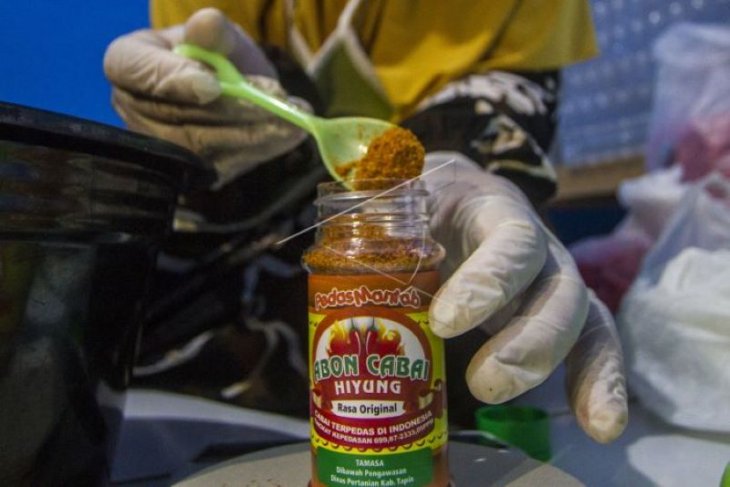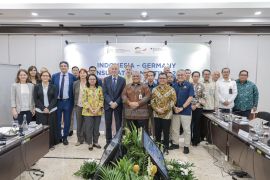Those believing that spicier food is better should give Hiyung bird's eye chili a try as a side dish.
Named after its home land, Hiyung is recognized as the hottest bird's eye chili in Indonesia, with the level of spiciness 17 times higher than other varieties of bird's eye chili (Capsicum frutescens L).
However, it is vouched that the chili only attains its peak level of spiciness when it is planted in Hiyung Village, Tapin District of South Kalimantan.
"According to a test by the Agriculture Ministry, Hiyung chili is 17 times spicier than other (bird's eye) chili in Indonesia," Tapin District Head H. M. Arifin Arpan stated.
The unique fact is that Hiyung chili would be less spicy if it were to be planted outside Hiyung Village, Arpan remarked.
"It tastes different even in the neighboring village. We suspect that it was caused by the soil acidity," the district head pointed out.
Hiyung Village has mostly alluvial soil, with acidity level at 3.4-3.6.
A test conducted by the Agriculture Ministry indicated that Hiyung has a capsaicin content of 2,333.05 part per million (ppm), while the other type of bird's eye chili, on an average, contain 200 ppm of capsaicin. Rainbow chili, bred by researcher of the Bogor Agriculture University (IPB), has up to 1,600 ppm of capsaicin content and is five times hotter than common chili.
Capsaicin is an active component of chili peppers that determines a chili's spiciness.
Arpan highlighted the other advantage that Hiyung chili can be stored for 10-16 days at room temperature.
In November 2020, the Tapin district administration received the certificate of Geographical Indication (GI) for Hiyung chili as an identity to maintain the commodity's reputation, quality, and characteristic.
Some other species of chili placed on the list of hottest chili in Indonesia are gendot chili from Dieng, Central Java and Katokkon chili that grows in Toraja, South Sulawesi. Both are in the same species of Capsicum chinense, or widely known as Habanero.
Export to Spain
Hiyung chili is nothing short of a blessing for the local farmers after they failed to cultivate rice in their field.
It was first brought to the village by a local farmer Soebarjo in 1993. He planted 200 seeds taken from the neighboring village of Linuh, Tapin District. It turned out that the chili had grown better in Hiyung Village and has a higher spiciness level as compared to its parent seeds.
Since then, farmers in the village switched to Hiyung chili, as they could not get maximum yield from the paddy field in the swamp land.
The chili's cultivation area has increased, from 145 hectares in 2019 to 182 hectares in 2020. The production of Hiyung chili in 2019 has reached 1,596 tons, according to the Tapin Agriculture Office.

Fluctuations in the chili market have driven farmers to come up with ways to keep the commodity’s price favorable.
Chief of the Karya Bakti farmers group, Junaidi, noted that the bitter experience from chili price decline in 2015 had pushed farmers to find a solution. At the time, Hiyung chili was only priced at Rp5,000 – Rp7,000 per kg, while its normal price could reach Rp50 thousand to Rp80 thousand per kg.
“We could not do anything at that time. We did not sell the harvest and offered it to anyone keen to pick chili in the field,” he stated.
With the local government’s support, Junaidi led farmers to produce powdered chili.
“From 10 kg of fresh chili, we dried it to make 3.5 kg of dried chili and produce 98-100 bottles each containing 35 grams of powdered chili,” he remarked.
It takes four days to dry the fresh chili under the sun, though the drying takes a mere 20 hours with a drier machine. The dried chili is then placed in an oven for 20 minutes to absorb its water content before being sent for milling.
Currently, Hiyung farmers have processed 25 percent of their production into powdered chili.
“This year, we have planned to export the product to Spain. We have set a target to absorb 50 percent (of fresh chili) to process it into powdered chili,” he stated.
Related news: Conservation efforts put Curiak Island on the map --- literally
Related news: A closer look at Bekantan's life in Curiak Island
Close
EDITED BY INE
Editor: Fardah Assegaf
Copyright © ANTARA 2021












